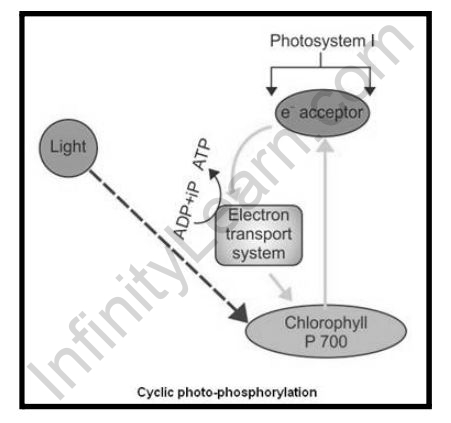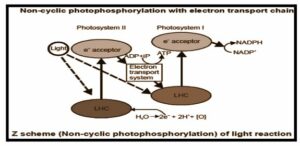Table of Contents
Cyclic and Noncyclic Photophosphorylation: Photosynthesis is the process by which the phosphorylation of the ADP to produce ATP occurs with the help of sunlight energy known as photophosphorylation. There are only two sources of energy that are accessible to living things: sunlight and the reduction-oxidation (redox) reaction. All living things produce ATP, which is a standard energy source for life. Typically, in photosynthesis, this involves photolysis, or photodissociation, of water and the indirect flow of electrons from water to photosystem II.
In the process of photophosphorylation, light energy is used to make the electron supplier of high energy and to receive low electrons. The electrons then move from the donor to the receiver suddenly through an electron transport chain.
In simple terms, Photophosphorylation is the use of sunlight energy in phosphorylate ADP to produce ATP during photosynthesis.
The process of photophosphorylation leading to the movement of electrons in the form of an ATP atomic cycle is called cyclic photophosphorylation. In this process, plant cells simply replicate ADP to ATP for instant energy. This process usually occurs in the thylakoid layer and uses Photosystem I and chlorophyll P700. During cyclic photophosphorylation, electrons are transferred back to P700 instead of moving to NADP from an electron receiver. This decrease in the flow of electrons from the receiver to the P700 causes the formation of ATP atoms.
ATP and Reaction
ATP is produced by an enzyme called ATP synthase. Both the composition of this enzyme and its key component are remarkably similar to all known species.
ATP synthase is driven by a potential electrochemical transmembrane channel, usually in the form of a proton channel. The role of the electron transport chain to produce this gradient. In all organisms, a redox reaction sequence is used to create a possible transmembrane electrochemical gradient or known as a proton motive force (pmf).
Redox reaction is a chemical reaction when electrons are converted from a donor molecule to a receiving molecule. The main energy that drives this reaction energy is Gibbs’ reactants and products. Gibbs is a free power provided (“free”) to do the job. Any free-flowing Gibbs system response will proceed automatically (given that the structure is isobaric and also adiabatic), although the reaction may proceed slightly if blocked.
The conversion of electrons from a high-energy molecule (donor) to a low-energy molecule (receiver) can be systematically divided into a series of interactive redox reactions. This is an electron transport chain.
The fact that the reaction may be thermodynamical does not mean that it will actually happen. The combination of hydrogen gas and oxygen does not burn automatically. It is necessary to provide the activation power or reduce the internal capacity for system activation, in order to make the biochemical chemical reactions continue at a beneficial rate. Biological systems utilize complex macromolecular structures to reduce the functional capacity of biochemical reactions.
Thermodynamic reactions that range from high-energy to low-energy conditions such as cost-sharing, or the construction of an osmotic gradient, in such a way that free system energy is reduced and makes it thermodynamically possible, while useful work is completed simultaneously.
Electron transport chains (commonly referred to as ETC) generate energy in the form of a transmembrane electrochemical channel. This energy is used to perform important tasks. The channel can be used to transport molecules throughout the membrane. It can be used to perform mechanical functions, such as flagella of surrounding bacteria. It can be used to produce ATP and NADPH, the high-energy molecules needed for growth.
Inside the chloroplast, there are thylakoid discs with a phospholipid bilayer membrane, consisting of synthetic proteins, that allow for the process of cyclic photophosphorylation and non-cyclic.
We all well remember the complete process of photosynthesis. It is a biological process that converts light energy into chemical energy. In this way, light energy is captured and used to convert carbon dioxide and water into glucose and oxygen gas. The complete process of photosynthesis is done in two ways:
Light Reaction

The process of light reaction occurs in the chloroplast granite. When light energy is converted into chemical energy such as ATP and NADPH. In this simplest reaction, the addition of pre-light phosphate or ATP synthesis by cells is known as photophosphorylation.
Dark Reaction
In the dark reaction, the energy produced at the beginning of the light reaction is used to convert carbon dioxide into carbohydrates. The area where this occurs is the chloroplast stroma.
We will look at the broader process of photophosphorylation i.e. light reaction:
Photophosphorylation is the process of creating energy-rich ATP molecules by converting the phosphate group into an ADP molecule where light is present. This process can be a cycle process or a non-cyclic process.
Non-Cyclic Photophosphorylation

Another form of light reaction, non-cyclic photophosphorylation, is a two-phase process that combines two different chlorophyll photosystems. In the clear reaction, non-cyclic photophosphorylation occurs in the thylakoid membrane. When it starts, the water molecule is divided into 2H + + ½ O2 + 2 by a process called photolysis (light separation). Then two electrons from the water molecule are stored in photosystem II, while 2H + and ½ O2 are released for further use. The photon is then absorbed by the chlorophyll pigments around the central reaction centre of the photographic system. Light stimulates electrons of each colour, producing a chain reaction at the end that transmits energy to the core of photosystem II, stimulating two electrons transferred to the main electron receptor, pheophytin. Lack of electrons complements by taking electrons from another water molecule. Electrons are transferred from pheophytin to plastoquinone, taking 2 electrons from Pheophytin, and two ions of hydrogen from stroma to form PQH2, which is later broken down into PQ, 2 electrons are released into the Cytochrome b6f complex and two hydrogen ions are left. without thylakoid lumen. The electrons then travel through Cyt b6 and Cyt f. They are then transferred together with plastocyanin, which activates hydrogen ions (H +) to force them into the thylakoid space. This produces a gradient, which causes hydrogen ions to flow back to the chloroplast stroma, by activating ATP regeneration.
Photosystem II was complex and replaced lost electrons in an external source; however, the other two electrons are not returned to photosystem II as they would in a cycle. Instead, renewable electrons are transferred to the photosystem I complex, which increases their energy level using a second photon of the sun. Extremely stimulated electrons are transferred to the receptor molecule, but this time they transfer to the enzyme known as Ferredoxin-NADP + reductase which they use to stimulate the reaction (as shown below):
NADP + + 2H + + 2e- → NADPH + H +
This consumes hydrogen ions created by water separation, leading to the complete formation of ½ O2, ATP, and NADPH + H + using solar photons and water. The incorporation of NADPH into chloroplast can help regulate which electron pathways are associated with light reactions. When chloroplast drops to the ATP level of the Calvinist cycle, NADPH will accumulate, and the plant may move from a non-circulating flow to a cyclic electron.
Also read: Pigments Involved in Photosynthesis
FAQs
1. Describe the Process of Non-cyclic Photophosphorylation in Details.
Ans: Phosphorylation refers to the process by which ATP is formed in ADP in a clear response to the process of photosynthesis. This process is performed in two different ways, namely, cyclic photophosphorylation and non-cyclic photophosphorylation.
Non-cyclic photophosphorylation refers to the process by which electrons are released from the excited image centre without returning. This process occurs when both the image systems I and II are involved. Water photolysis leads to the release of electrons, therefore, continuous water supply is required. In this process, both NADPH and ATP are formed.
2. Distinguish Between Cyclic and Noncyclic Photophosphorylation.
Ans: Differences between cyclic and noncyclic photophosphorylation include
Cyclic photophosphorylation occurs only in photosystem I but non-cyclic photophosphorylation occurs in both the image systems I and II.
In cyclic photophosphorylation, only ATP is produced, whereas, in non-cyclic photophosphorylation both NADPH and ATP are produced.
In cyclic photophosphorylation, electrons are released by photosystem I and returned to the system. On the other hand, in non-cyclic photophosphorylation, electrons expelled from photosystems do not return.
Water Photolysis does not occur in cyclic photophosphorylation, but comes from non-cyclic photophosphorylation.
Oxygen is not released from cyclic photophosphorylation but is released in the form of non-cyclic photophosphorylation.
Water is not used for cyclic photophosphorylation, but for non-cyclic photophosphorylation.



